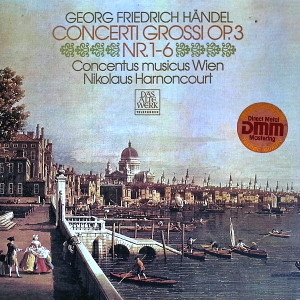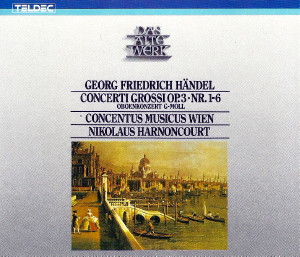 |
2 LP -
6.35545 EX - (p) 1981
|
 |
| 2 CD -
8.35545 ZA - (c) 1984 |
|
| Georg Friedrich
Händel (1685-1759) |
|
|
|
|
|
|
|
| Concerti grossi op, 3 Nr. 1-6
|
|
|
|
|
|
|
|
| Concerto grosso I B-dur, op.
3 Nr. 1 |
|
9' 28" |
A1 |
| Oboe I, II: Flauto (Blockflöte)
I, II; Violino I, II, Viola I, II; Fagotto
I, II; Violoncello, Violone, Cembalo I, II |
|
|
|
- Allegro
|
2' 52" |
|
|
| - Largo |
5' 03" |
|
|
| - Allegro |
1' 33" |
|
|
| Concerto grosso II B-dur, op.
3 Nr. 2 |
|
11' 59" |
A2 |
| Oboe I, II; Violino I, II
concertino; Violino I, II, Viola; Fagotto;
Violoncello I, II, Violone, Cembalo, Orgel |
|
|
|
- Vivace
|
2' 07" |
|
|
- Largo
|
2' 36" |
|
|
| - Allegro |
2' 20" |
|
|
- (Menuett)
|
1' 51" |
|
|
| - (Gavotte) |
3' 05" |
|
|
| Concerto grosso III G-dur,
op. 3 Nr. 3 |
|
7' 52" |
B1 |
| Oboe; Violino concertino;
Violino I, II, Viola; Fagotto,
Violoncello; Violone; Cembalo |
|
|
|
- Largo e staccato
|
0' 27"
|
|
|
| - Allegro |
2' 31" |
|
|
| - Adagio |
0' 57" |
|
|
- Allegro
|
3' 58" |
|
|
| Concerto grosso IVa F-dur,
op. 3 Nr. 4a |
|
12' 55" |
B2 |
| Oboe I, II; Violino I, II,
Viola; Fagotto, Violoncello; Violone;
Cembalo |
|
|
|
- Andante - Allegro
|
6' 16" |
|
|
| - Andante |
2' 10" |
|
|
| - Allegro |
1' 34" |
|
|
- Minuetto I, II,
alternativo
|
2' 55" |
|
|
| Concerto grosso IVb F-dur,
op. 3 Nr. 4b |
|
10' 22" |
C1 |
| Oboe I, II; Violino I, II,
Viola; Fagotto, Violoncello; Violone;
Cembalo |
|
|
|
| - Largo |
1' 45" |
|
|
| - Allegro |
3' 21" |
|
|
| - Largo |
3' 16" |
|
|
| - Allegro |
2' 00" |
|
|
| Concerto grosso V d-moll, op.
3 Nr. 5 |
|
10' 24" |
C2 |
| Oboe I, II; Violino I, II,
Viola; Fagotto, Violoncello; Violone;
Cembalo |
|
|
|
| - (Grave) |
1' 45" |
|
|
| - Allegro |
2' 31" |
|
|
| - Adagio |
1' 39" |
|
|
- Allegro ma non troppo
|
1' 39" |
|
|
| - Allegro |
2' 40" |
|
|
Concerto grosso VI
D-dur/d-moll, op. 3 Nr. 6
|
|
7' 22" |
D1 |
| - Vivace |
2' 56" |
|
|
- (Adagio) improvisiert
|
1' 10" |
|
|
| - (Allegro) |
3' 16" |
|
|
Concerto g-moll, Hwv 287
|
|
8' 45" |
D2 |
Oboe; Violino I, II, Viola;
Violoncello, Violone, Cembalo
|
|
|
|
| - Grave |
2' 33" |
|
|
| - Allegro |
1' 56" |
|
|
- Sarabande - Largo
|
2' 16" |
|
|
| - Allegro |
2' 00" |
|
|
|
|
|
|
| CONCENTUS MUSICUS
WIEN (mit Originalinstrumenten) |
|
| Nikolaus
Harnoncourt, Leitung |
|
|
Luogo
e data di registrazione
|
Casino Zögernitz,
Vienna (Austria) - dicembre 1978, maggio
1980 e gennaio 1981 (Concerti op. 3 Nr.
1-6)
Palais Rasumowsky, Vienna
(Austria) - marzo e aprile 1973 (Concerto
g-moll)
|
|
Registrazione
live / studio
|
| studio |
Producer
/ Engineer
|
-
|
Prima Edizione CD
|
Teldec
"Das Alte Werk" - 8.35545 ZA - (2 cd) -
42' 47" + 37' 14" - (c) 1985
|
Prima
Edizione LP
|
Telefunken "Das
Alte Werk" - 6.35545 EX
- (2 lp) - 42'
47"
+ 37' 14"
- (p) 1981
|
Note
|
| La registrazione del Concerto
g-moll, Hwv 287 è la stessa già edita
nel 1974 Telefunken
SAWT 9618-A. |
|
|
Comments on the
Performance
|
It has been our aim to
highlight the element of dialogue, the
“musical speech pattern” by employing
the phrasing appropriate to
contemporary practice and by arranging
the musicians in a way that enhances
that dialogue. In other words, we have
been generous with our phrasing, even
where there are no
corresponding indications in
Handel’s score,
because we are convinced that most
composers of the day and
Handel in particular relied upon the
performers to articulate the musical
figures. Of course trills
and grace notes were added when
required. We were very cautious about
making “arbitrary changes", i.e.
adding far-reaching
ornamentation, which was only employed
when the texture of the music
warranted it. We take the view that in
recordings, as opposed to live
concerts, only the absolutely
essential embellishments
should be played because a record can
be listened to more than once;
spontaneity arising from the essence
of the music cannot be repeated, and
improvised ornaments all too easily
acquire quasi-obbligato
characteristics. The endings of some
adagio sections call for
ornamentation, e.d. at the
end of the second movement of Concerto
No. 1; on other
occasions Handel seems to have aimed
at a surprisingly abrupt ending. Were
the opening movement or ending has a
dotted rhythm in the manner of an
overture, we have emphasised that
rhythm in accordance both with
contemporary practice and the mood of
the piece in question (end of the
first movement of Concerto No. 2;
introduction to Concertos Nos, 4a and
5). In No. 2 the orchestra is divided
into two, and occasionally into three
sections. We have added the organ as a
continuo instrument to
those sections (wind nr strings) which
assume the concertino role, and the
harpsichord to the tutti (ripieno).
No. 6 was certainly not performed in
the manner in which it has been handed
down to us. It consists of two fast
movements, of which the first is in D
major and the second in D minor, and
they do not fit together at all well.
It is reasonable to assume that the
organist required for the last
movement improvised a bridging adagio,
such as Handel expressly called for in
several of his organ concertos.
Nikolaus
Harnoncort
Translation:
Lindsay Craig
|
|
Nikolaus
Harnoncourt (1929-2016)
|

|

|
|

